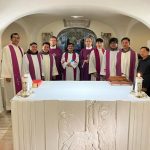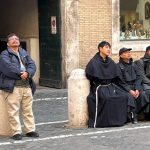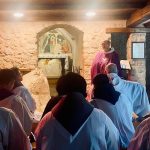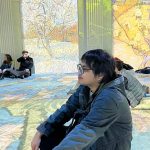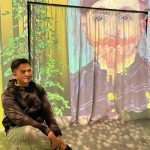Friar Zachary HAYES, OFM [a noted American Franciscan theologian], said: “For Francis and Bonaventure, historical realities point our attention to the humble, tender elements of the world, to discover there, important signals of the presence of the divine. How can one look at the figure on the cross without asking: What is the nature of creative and redemptive love? What is truly creative power?”
The St. Bonaventure Continuing Formation Pilgrimage began with a visit just down the street from the Seraphicum College in Rome, to the Tre Fontane Shrine [Three Fountains]. While there, the Little Sisters of Jesus spoke to the pilgrims about the spirituality of work, and in particular, the work they do, in a multi-faith context, especially among Muslims.
While visiting the major basilicas in Rome, the pilgrims reflected on the creative power of Franciscan art as it reflects the mercy of Christ Jesus. During the Masses celebrated at the tomb of St. Peter, and in the Basilica of St. John Lateran, the pilgrims reflected on how their lives might better point “to the humble, tender elements of the world, to discover there, important signals of the presence of the divine.”
Their visit to Greccio was a true experience of Christmas, as touched by God through nature. That early March day featured snow, hail, and a rainbow to remind them of God’s promises, fulfilled in Christ Jesus.
In Assisi and La Verna, the pilgrims not only walked in the footsteps of Saints Francis and Clare, but also entered into the silence of reflection, which bore fruit during their evening discussions about the way God is working in their lives of fraternity and ministry.
An unusual addition to the itinerary was a visit to the Van Gogh Experience in Rome, on the first day of the pilgrimage. The pilgrims sat in a large room where the art of Van Gogh was projected and swirled around them on the walls, floor, and ceiling. It was an opportunity to consider how they might immerse themselves in the art they were viewing, and revisit those images while they prayed during their time of pilgrimage.
Their time in Assisi ended with a visit to the library of the Sacro Convento and an examination of one of its oldest manuscripts. The librarian, Friar Carlo BOTTERO, presented a bible from 1250, which belonged to Friar John of Parma. He explained that the illuminated letter “I” on the first page began the phrase, “In the beginning…” The figures within the decorated letter included Christ, the author of the book; Adam, the protagonist of the story; Satan, the antagonist of the story; and a praying Francis of Assisi, as the reader of the story. This image brought the pilgrims full circle back to the beginning of their pilgrimage and the Van Gough Experience, as they were challenged to see themselves within the incredible story of salvation history, while continuing to ask the questions: “What is the nature of creative and redemptive love? What is truly creative power?”
Those participating in the pilgrimage included Friar Michael LASKY (leader); Friars John Baptist NGUYỄN (Ngọc Điền), Dominic NGUYỄN (Văn Tiến), and Peter NGUYỄN (Ngọc Duy) of Vietnam; Friars Abdiwa Agung Yesaya PERANGIN ANGIN, Eriksend Okripo SITEPU, Gervatius Gindo SARAGIH, Sevan Rinaldi SEMBIRING, and Andreas BUDIANTO of Indonesia; Friar Paweł BLOK of Kazakhstan; Friar Jacob CARAZO of the United States; and Friar John KIM of South Korea.
A special thank you to the friar translators who accompanied the pilgrims in Rome and Assisi, Friars Adrianus SITEPUS and Pio PURBA.
Friar Michael LASKY,
General Delegate for Justice, Peace and Integrity of Creation









